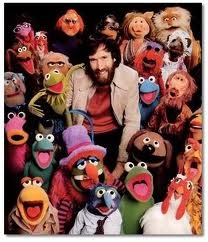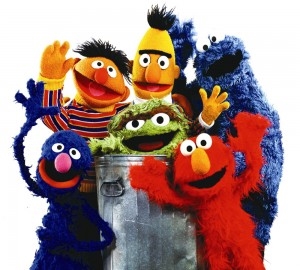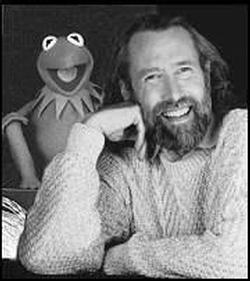 |
| (http://randomwallpaper111.blogspot.com/2011/09/jim-hensons.html ()) |
"A hero is someone who has given his or her life to something bigger than oneself" (Joseph Campbell). This quote by Joseph Campbell is a fitting description of a man who has entertained and educated literally millions of people around the globe- Jim Henson. Anybody who has ever seen an episode of Sesame Street, or who knows who Kermit the Frog, Miss Piggy, or Cookie Monster is knows at least something about Jim Henson. Henson was born September 24, 1936, in Mississippi. He studied art at the University of Maryland, where he met his wife. Henson graduated from college in 1960. Throughout his college years, Henson created many new characters for TV shows. Throughout the 1950s and 1960 Henson became quite famous for his new creations that he called "Muppets". Muppets were a more expressive kind of puppet that many kids enjoyed watching and interacting with. While working on his many TV productions, Henson showed people around him that money and beauty were not the important things in life. Henson also proved that if you put your mind to it, you could accomplish anything. Henson created over 2,000 Muppets in his life ("Jim Henson"), and he did not think of himself as any better than his coworkers. Jim Henson's concern for others, his creativity, and his humility prove him to be a modern day hero to adults and children alike.
 |
| Characters on Sesame Street (http://toybook.com/new-sesame-street-titles-on-moving-picture-books ()) |
Jim Henson didn't care about making a lot of money or being famous; he cared about teaching kids and entertaining adults. Throughout his career Henson created many Muppets. Each Muppet had its own personality that people could connect to. "The humor and whimsy of his characters continue to entertain each new generation" ("Jim Henson Biography"). Each character is complex enough to keep the adults attention and enjoyment. On the other hand each character is simple enough for little kids to understand and crazy enough for little kids to enjoy. For instance, Henson put a twist on the "scary monster". With characters like Cookie Monster and Oscar the Grouch, he made the monsters relatable to little children. Even though Henson has died, the little kids of this generation still love to watch Sesame Street. Henson loved to watch little kids learn the basics of life. "Through the use of warm humor, Henson and his puppets helped children learn numbers, letters, and simple lessons of life" (Margolis). Henson wanted to use television and his creations as more than simple entertainment. He wanted children to be taught things in a fun way. "'Sesame Street' is still with us and so is Jim Henson's world. It's a world made sweet with the knowledge that you never outgrow" ("TOPICS OF THE TIMES"). Henson cared about the development of children and the enjoyment of adults. Even though Henson was famous and wealthy, he dedicated his life's work to improving the lives of children and adults through fun and humor.
Even though Henson could use his fame and fortune to get whatever he wanted, he just wanted to have fun with his job. Henson was seen as many things at his work. Some coworkers even described him as "a gentle, soft-spoken, hard-working man with a keen sense of humor" ("Jim Henson"). Henson was seen by other people as kind and helpful. He did not think he deserved better than others because he created a world famous TV show. He was just having fun working his imagination. Even though Henson was very sick he said nothing. "While the negotiations [with Disney] were ... in progress, Henson became seriously ill. A kind and patient man, Henson did not alert a doctor or visit a hospital because he did not believe he was sick: nor did he want to bother anyone" ("Jim Henson"). Henson did not want to disrupt another person's life or the deal with Disney. Henson believed that he could get over his illness if he just gave it time. Unfortunately because Henson was so humble, he did not call a doctor soon enough and his humility resulted in his death. Even though Henson's humility turned out to be bad people today still know him for his kind and gentle ways.
 |
| ( http://top-people.starmedia.com/arte/jim-henson_17170.html) |
Henson created a world-wide show with a new type of puppet, entertaining the world with his creations. Henson was bored one day and so he decided to create a new character with the things he already had: "Kermit was made from Henson's mother's old spring coat and a ping pong ball cut in half. Kermit did not begin as a frog but evolved into one. Similarly, Kermit's character gradually became more complex" ("Jim Henson"). Henson did not go out and buy fancy material, he used items he found around his house. Henson had the imagination to picture a new type of puppet when he saw his mother's coat. He called his new creation "Muppet", a combination of the words "puppet" and "marionette" ("Jim Henson"). "Unlike puppets, who have solid, unchanging heads, Muppets were softer, with mouths that moved and expressive eyes. The Muppets were more animated puppets" ("Jim Henson"). Before Henson's Muppet creations; there were only puppets or marionettes. The new expressive Muppets were more appealing to all generations than puppets and marionettes. Henson had the imagination to create over 2,000 Muppets in his lifetime and he had fun doing it.
 |
| (http://muppet.wikia.com/wiki/Kermit_the_Frog ()) |
Few people can say that they spent their life helping millions of children, but Jim Henson can. Motivated by his desire to entertain and educate, Henson used his creativity to benefit others instead of himself. His creations, the Muppets, are recognized the world over and will be for generations to come. Henson has inspired many to use their imaginations to create unordinary things and to have fun while doing the things they enjoy in life. As Kermit the Frog would say, "Keep believing, keep pretending; we've done just what we've set out to do, thanks to the lovers, the dreamers, and you!"
Works Consulted
"Jim Henson Biography." The Jim Henson Legacy Home Page. The Jim Henson Legacy. Web. 10
Dec. 2011. .
" Jim Henson." 2011. Biography.com 10 Dec 2011, 05:39
http://www.biography.com/people/jim-henson-9335615
"Jim Henson." DISCovering U.S. History. Detroit: Gale, 2003. Gale Student Resources In Context.
Web. 11 Dec. 2011.
"Jim Henson." Encyclopedia of World Biography. Vol. 19. Detroit: Gale, 1999. Gale Student
Resources In Context. Web. 10 Dec. 2011.
Margolis, Tina. "Jim Henson." American National Biography (2010): 1. Biography Reference
Center. Web.10 Dec. 2011.
"TOPICS OF THE TIMES; Coo-kie!(Editorial Desk)(Editorial)." New York Times 17 May 1990.
Global Issues In Context. Web. 11 Dec. 2011.
Page created on 1/14/2012 12:00:00 AM
Last edited 1/4/2017 5:05:35 PM
